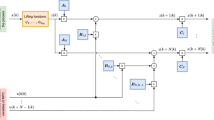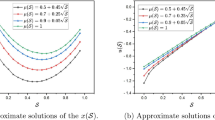Abstract
This paper primarily discusses the solution to multi-degree of freedom linear time invariant fractional order dynamic systems with fractional actuators in detail. This solution is of significant importance due its ease of usage and compatibility with digital systems. Subsequently, a modified model predictive control (MMPC) scheme is introduced that is an infusion of a novel discrete-time robust sliding mode control and model predictive control. The proposed modified model predictive control algorithm is proven to illustrate robustness against uncertainty in system’s parameters and external disturbance while abstaining from the undesirable characteristics of sliding mode control such as chattering. By employing the MMPC scheme, it is possible to constrain the control inputs to be less than pre-determined bounds and by this mean, take a step toward making this algorithm more suitable for practical applications. A general and illustrious plant, represented by the famous Torvik’s three parameter model, is selected and the proposed control scheme is applied to further elucidate the merits, qualities and capabilities of MMPC for fractional systems. The corresponding MATLAB code for the simulation section is also presented in the appendix of the paper. A discussion is also included that examines the effectiveness of MMPC and provides insights for future works.




Similar content being viewed by others
References
Sun HG, Zhang Y, Baleanu D et al (2018) A new collection of real world applications of fractional calculus in science and engineering. Commun Nonlinear Sci Numer Simul 64:213–231. https://doi.org/10.1016/j.cnsns.2018.04.019
Bagley RL, Torvik PJ (1983) A theoretical basis for the application of fractional calculus to viscoelasticity. J Rheol (N Y N Y) 27:201–210. https://doi.org/10.1122/1.549724
Schneider WR, Wyss W (1989) Fractional diffusion and wave equations. J Math Phys 30:134–144. https://doi.org/10.1063/1.528578
Magin RL, Abdullah O, Baleanu D, Zhou XJ (2008) Anomalous diffusion expressed through fractional order differential operators in the Bloch–Torrey equation. J Magn Reson 190:255–270. https://doi.org/10.1016/j.jmr.2007.11.007
Singh H, Srivastava HM, Kumar D (2018) A reliable algorithm for the approximate solution of the nonlinear Lane–Emden type equations arising in astrophysics. Numer Methods Partial Differ Equ 34:1524–1555. https://doi.org/10.1002/num.22237
Chen W, Hu S, Cai W (2016) A causal fractional derivative model for acoustic wave propagation in lossy media. Arch Appl Mech 86:529–539. https://doi.org/10.1007/s00419-015-1043-2
Povstenko Y (2014) Fractional thermoelasticity. In: Encyclopedia of thermal stresses. Springer, Dordrecht, pp 1778–1787
Magin RL (2010) Fractional calculus models of complex dynamics in biological tissues. Comput Math with Appl 59:1586–1593. https://doi.org/10.1016/j.camwa.2009.08.039
Drapaca CS, Sivaloganathan S (2012) A fractional model of continuum mechanics. J Elast 107:105–123. https://doi.org/10.1007/s10659-011-9346-1
Homaeinezhad MR, Shahhosseini A (2020) Fractional order actuation systems: theoretical foundation and application in feedback control of mechanical systems. Appl Math Model 87:625–639. https://doi.org/10.1016/j.apm.2020.06.030
Tepljakov A, Vunder V, Petlenkov E et al (2019) Fractional-order modeling and control of ionic polymer-metal composite actuator. Smart Mater Struct 28:84008. https://doi.org/10.1088/1361-665x/ab2c75
Singh H, Srivastava HM (2020) Numerical investigation of the fractional-order Liénard and duffing equations arising in oscillating circuit theory. Front Phys. https://doi.org/10.3389/fphy.2020.00120
Singh H (2020) Analysis for fractional dynamics of Ebola virus model. Chaos, Solitons Fractals 138:109992. https://doi.org/10.1016/j.chaos.2020.109992
Škovránek T, Podlubny I, Petráš I (2012) Modeling of the national economies in state-space: a fractional calculus approach. Econ Model 29:1322–1327. https://doi.org/10.1016/j.econmod.2012.03.019
Bas E, Acay B, Ozarslan R (2019) Fractional models with singular and non-singular kernels for energy efficient buildings. Chaos Interdiscip J Nonlinear Sci 29:023110. https://doi.org/10.1063/1.5082390
Bohner M, Hatipoğlu VF (2019) Dynamic cobweb models with conformable fractional derivatives. Nonlinear Anal Hybrid Syst 32:157–167. https://doi.org/10.1016/j.nahs.2018.09.004
Du H, Perré P, Turner I (2020) Modelling fungal growth with fractional transport models. Commun Nonlinear Sci Numer Simul 84:105157. https://doi.org/10.1016/j.cnsns.2019.105157
Singh H, Srivastava HM (2019) Jacobi collocation method for the approximate solution of some fractional-order Riccati differential equations with variable coefficients. Phys A Stat Mech Its Appl 523:1130–1149. https://doi.org/10.1016/j.physa.2019.04.120
Singh H, Srivastava HM (2020) Numerical simulation for fractional-order Bloch equation arising in nuclear magnetic resonance by using the Jacobi polynomials. Appl Sci 10:2850. https://doi.org/10.3390/app10082850
Singh H, Singh CS (2018) A reliable method based on second kind Chebyshev polynomial for the fractional model of Bloch equation. Alex Eng J 57:1425–1432. https://doi.org/10.1016/j.aej.2017.07.002
Singh H (2017) Operational matrix approach for approximate solution of fractional model of Bloch equation. J King Saud Univ Sci 29:235–240. https://doi.org/10.1016/j.jksus.2016.11.001
Singh H, Pandey RK, Srivastava HM (2019) Solving non-linear fractional variational problems using Jacobi polynomials. Mathematics 7:224. https://doi.org/10.3390/math7030224
Bagley RL, Calico RA (1991) Fractional order state equations for the control of viscoelasticallydamped structures. J Guid Control Dyn 14:304–311. https://doi.org/10.2514/3.20641
Padula F, Alcántara S, Vilanova R, Visioli A (2013) control of fractional linear systems. Automatica 49:2276–2280. https://doi.org/10.1016/j.automatica.2013.04.012
Baleanu D, Machado JAT, Luo ACJ (eds) (2012) Fractional dynamics and control. Springer, New York, NY. https://doi.org/10.1007/978-1-4614-0457-6
Ameen I, Baleanu D, Ali HM (2020) An efficient algorithm for solving the fractional optimal control of SIRV epidemic model with a combination of vaccination and treatment. Chaos, Solitons Fractals 137:109892. https://doi.org/10.1016/j.chaos.2020.109892
Wang S, Bekiros S, Yousefpour A et al (2020) Synchronization of fractional time-delayed financial system using a novel type-2 fuzzy active control method. Chaos, Solitons Fractals 136:109768. https://doi.org/10.1016/j.chaos.2020.109768
Homaeinezhad MR, Yaqubi S, Fotoohinia F (2019) FEA based discrete-time sliding mode control of uncertain continuum mechanics MIMO vibrational systems. J Sound Vib 460:114902. https://doi.org/10.1016/j.jsv.2019.114902
Dumitru B, Kai D, Enrico S (2012) Fractional calculus: models and numerical methods. World Scientific, Singapore
Homaeinezhad MR, Shahhosseini A (2020) High-performance modeling and discrete-time sliding mode control of uncertain non-commensurate linear time invariant MIMO fractional order dynamic systems. Commun Nonlinear Sci Numer Simul 84:105200. https://doi.org/10.1016/j.cnsns.2020.105200
Podlubny I (1999) Fractional differential equations. In: An introduction to fractional derivatives, fractional differential equations, some methods of their solution and some of their applications. Academic Press, San Diego
Garrappa R (2018) Numerical solution of fractional differential equations: a survey and a software tutorial. Mathematics 6:16. https://doi.org/10.3390/math6020016
Pisano A, Rapaić MR, Jeličić ZD, Usai E (2010) Sliding mode control approaches to the robust regulation of linear multivariable fractional-order dynamics. Int J Robust Nonlinear Control 20:2045–2056. https://doi.org/10.1002/rnc.1565
Si-Ammour A, Djennoune S, Bettayeb M (2009) A sliding mode control for linear fractional systems with input and state delays. Commun Nonlinear Sci Numer Simul 14:2310–2318. https://doi.org/10.1016/j.cnsns.2008.05.011
Farges C, Moze M, Sabatier J (2009) Pseudo state feedback stabilization of commensurate fractional order systems. In: 2009 European Control Conference (ECC). IEEE, pp 3395–3400
Biswas Raj Kumar, Sen S (2011) Fractional optimal control problems: a pseudo-state-space approach. J Vib Control 17:1034–1041. https://doi.org/10.1177/1077546310373618
Monje CA, Chen Y, Vinagre BM, Xue F-B (2010) Fractional-order systems and controls. Springer, Berlin
Rhouma A, Bouani F, Bouzouita B, Ksouri M (2014) Model predictive control of fractional order systems. J Comput Nonlinear Dyn 9:031011. https://doi.org/10.1115/1.4026493
Joshi M, Vyawahare V, Patil M (2014) Model predictive control for fractional-order system—a modeling and approximation based analysis. In: Proceedings of the 4th international conference on simulation and modeling methodologies, technologies and applications. SCITEPRESS - Science and Technology Publications, pp 361–372
Bouani F, Rhouma A (2014) Robust model predictive control of uncertain fractional systems: a thermal application. IET Control Theory Appl 8:1986–1994. https://doi.org/10.1049/iet-cta.2014.0703
Mayne DQ, Rawlings JB, Rao CV, Scokaert POM (2000) Constrained model predictive control: stability and optimality. Automatica 36:789–814. https://doi.org/10.1016/S0005-1098(99)00214-9
Limon D, Alamo T, Camacho EF (2005) Enlarging the domain of attraction of MPC controllers. Automatica 41:629–635. https://doi.org/10.1016/j.automatica.2004.10.011
Tian Z, Yuan J, Zhang X et al (2018) Modeling and sliding mode predictive control of the ultra-supercritical boiler-turbine system with uncertainties and input constraints. ISA Trans 76:43–56. https://doi.org/10.1016/j.isatra.2018.03.004
Caballero-Barragán H, Osuna-Ibarra LP, Loukianov AG, Plestan F (2018) Sliding mode predictive control of linear uncertain systems with delays. Automatica 94:409–415. https://doi.org/10.1016/j.automatica.2018.04.040
Yaqubi S, Homaeinezhad MR (2020) Analytical single-mode sliding predictive control of arbitrarily switched nonlinear systems incorporating dynamical variations. Nonlinear Anal Hybrid Syst 38:100937. https://doi.org/10.1016/j.nahs.2020.100937
Homaeinezhad MR, Yaqubi S (2019) Discrete-time sliding-surface based control of parametrically uncertain nonlinear systems with unknown time-delay and inaccessible switching mode detection. Int J Control. https://doi.org/10.1080/00207179.2019.1605205
Yaqubi S, Homaeinezhad M (2020) Nonlinear model predictive acceleration synchronization technique for rigid-model-based tracking control of multi-DOF flexible systems. Proc Inst Mech Eng Part K J Multi-body Dyn. https://doi.org/10.1177/1464419320919306
Yaqubi S, Homaeinezhad M (2020) Optimally designed Lyapunov–Krasovskii terminal costs for robust stable–feasible model predictive control of uncertain time-delay nonlinear dynamical systems. Proc Inst Mech Eng Part I J Syst Control Eng. https://doi.org/10.1177/0959651820952193
Rudolf Gorenflo FM (1997) Fractional calculus. In: Fractional calculus. pp 223–276
Caputo M (1967) Linear models of dissipation whose Q is almost frequency independent–II. Geophys J Int 13:529–539. https://doi.org/10.1111/j.1365-246X.1967.tb02303.x
Oustaloup A, Melchior P, Lanusse P, et al The CRONE toolbox for Matlab. In: CACSD. Conference proceedings. IEEE international symposium on computer-aided control system design (Cat. No.00TH8537). IEEE, pp 190–195
Sun G, Wu L, Kuang Z et al (2018) Practical tracking control of linear motor via fractional-order sliding mode. Automatica 94:221–235. https://doi.org/10.1016/j.automatica.2018.02.011
Stanislawski R, Latawiec KJ, Lukaniszyn M, et al (2016) Modeling and identification of fractional first-order systems with Laguerre-Grünwald-Letnikov fractional-order differences. In: 2016 21st international conference on methods and models in automation and robotics (MMAR). IEEE, pp 174–177
Lofberg J, YALMIP : a toolbox for modeling and optimization in MATLAB. In: 2004 IEEE international conference on robotics and automation (IEEE Cat. No.04CH37508). IEEE, pp 284–289
Bagley RL, Torvik PJ (1983) Fractional calculus—a different approach to the analysis of viscoelastically damped structures. AIAA J 21:741–748. https://doi.org/10.2514/3.8142
Homaeinezhad MR, Yaqubi S, Gholyan HM (2020) Control of MIMO mechanical systems interacting with actuators through viscoelastic linkages. Mech Mach Theory 147:103763. https://doi.org/10.1016/j.mechmachtheory.2019.103763
Author information
Authors and Affiliations
Corresponding author
Rights and permissions
About this article
Cite this article
Homaeinezhad, M.R., Shahhosseini, A. Parameter-disturbance-robust model predictive control of input-saturated MIMO fractional systems. Int. J. Dynam. Control 9, 1117–1131 (2021). https://doi.org/10.1007/s40435-020-00714-y
Received:
Revised:
Accepted:
Published:
Issue Date:
DOI: https://doi.org/10.1007/s40435-020-00714-y




